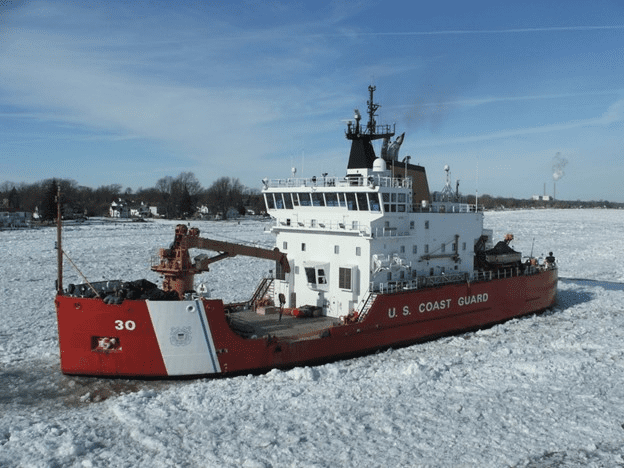
Recognizing the importance of maritime commerce on the Great Lakes, three U.S. senators are calling for legislation to help the Coast Guard keep the shipping lanes open during the winter.
“Inadequate icebreaking capacity in the Great Lakes is costing us thousands of American jobs and millions in business revenue. We must boost our icebreaking capacity in the Great Lakes to keep our maritime commerce moving,” said Sen. Tammy Baldwin (D-Wisconsin), who along with Sens. Todd Young (R-Indiana) and Gary Peters (D-Michigan) are reintroducing the Great Lakes Winter Commerce Act.
The bill would update the U.S. Coast Guard’s (USCG) Great Lakes icebreaking mission and increase the icebreaking capacity of the Great Lakes fleet to support “reasonable demands of commerce.”
According to a statement from Baldwin’s office, “the Coast Guard currently interprets the ‘reasonable demands of commerce’ as meaning that an ice-covered waterway is open until a second vessel is stuck in the ice for more than 24 hours as a result of another vessel’s inability to move. They only report to Congress ice restrictions in four connecting channels for the entire Great Lakes.”
The bill defines “reasonable demands of commerce” as the “safe movement of commercial vessels transiting ice-covered waterways in the Great Lakes, regardless of type of cargo, at a speed consistent with the design capability of Coast Guard icebreakers operating in the Great Lakes.”
A study commissioned by the Lake Carriers’ Association found that during the 2018-2019 ice-season, businesses that depend upon the Great Lakes maritime industry lost over $1 billion in revenues because of delays caused by inadequate icebreaking.
“This historic bill will codify into law a long time Coast Guard mission that protects national and economic security,” said Jim Weakley, president of the Lake Carriers’ Association.
The legislation authorizes $350 million for the construction of a new Great Lakes icebreaker.
The Coast Guard currently has one heavy icebreaker based at Cheboygan, Michigan, as well as six icebreaking tugs. The Great Lakes icebreaker USCGC Mackinaw (WLBB 30) can break ice up to 32 inches thick at continuous speeds of 3 knots. Commissioned in 2006, the 240-foot heavy icebreaker is the largest Coast Guard vessel on the Great Lakes. There are also Bay-class 140-foot icebreaking tugs that can break ice up to 22 inches thick, based at Cleveland, Detroit, Sault Ste. Marie, Michigan, Sturgeon Bay, Wisconsin, and St. Ignace in Michigan.
“Icebreaking in the Great Lakes is critical not just for Michigan’s economy, but for our entire country. As we have seen this winter, the economic crisis caused by the coronavirus pandemic has made the importance of icebreaking more vital than ever to our small business community,” Peters said.
Icebreaking capacity in the Great Lakes supports more than 90 million tons of cargo annually.
“Our legislation will support icebreaking missions to expand capacity to ship goods, create jobs, and strengthen the economy in Indiana and other Great Lake states,” Young said.
- A Day to Remember - September 11, 2023
- Indo-Pacific Maritime Security Exchange will examine emerging capabilities and capacity - July 12, 2023
- Cold Waters Spark Warm Relationship - April 20, 2023






